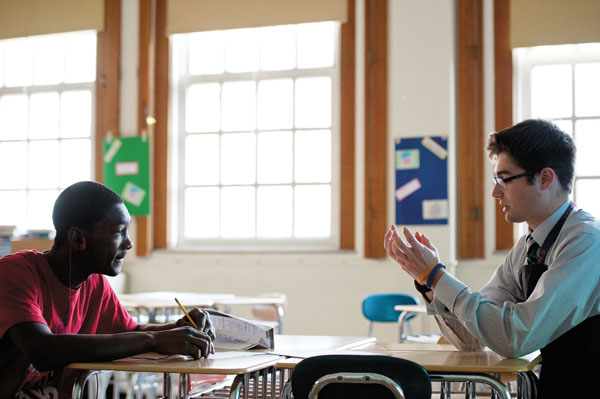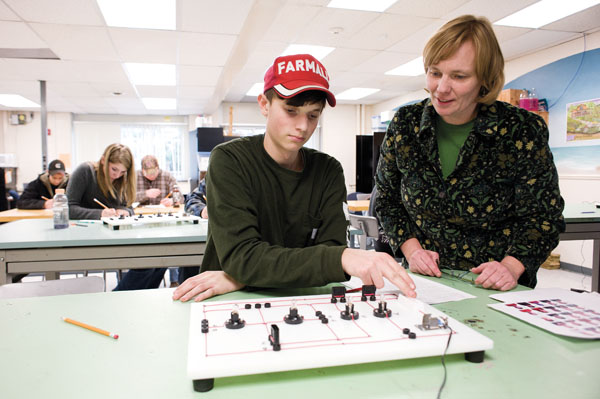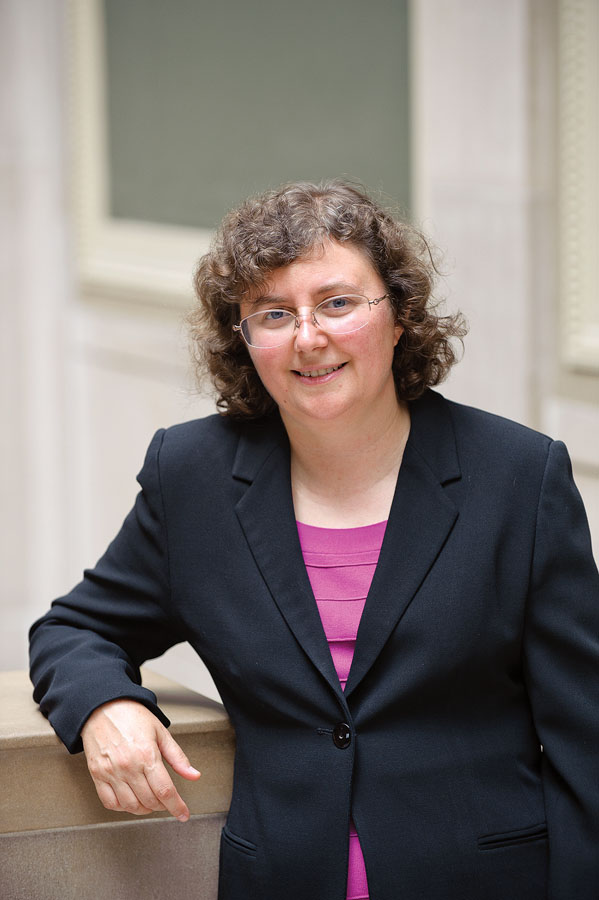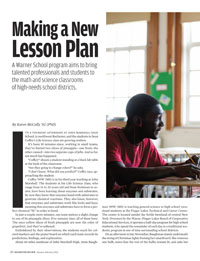Features
 COFFEY BREAK: Developing a rapport with students, such as Craig Stanford (left), is an important part of his teaching, says Coffey, who won the Rochester City School District’s Career in Teaching Award for First Year Teachers in 2010. (Photo: Adam Fenster)
COFFEY BREAK: Developing a rapport with students, such as Craig Stanford (left), is an important part of his teaching, says Coffey, who won the Rochester City School District’s Career in Teaching Award for First Year Teachers in 2010. (Photo: Adam Fenster)It’s a Thursday afternoon at John Marshall High School, in northwest Rochester, and the students in Sean Coffey’s Life Science class are growing restless.
It’s been 10 minutes since, working in small teams, they’ve buried two slices of pineapple—one fresh, the other canned—into two separate cups of jello. And so far, not much has happened.
“Coffey!” shouts a student standing at a black lab table at the back of the classroom.
“Are they going to change colors?” he asks.
“I don’t know. What did you predict?” Coffey says, approaching the student.
Coffey ’09W (MS) is in his third year teaching at John Marshall. The students in his Life Science class, who range from 14 to 20 years old and from freshman to senior, have been learning about enzymes and substrates. By now they know that enzymes bond with substrates to generate chemical reactions. They also know, however, that enzymes and substrates work like locks and keys, meaning that enzymes and substrates have to form a perfect chemical “fit” in order to bond.
In just a couple more minutes, one team notices a slight change to one of its pineapple slices. Five minutes later, all of them have. The once-yellow slices of fresh pineapple are now the color of grapefruit. And they’ve softened.
Emboldened by their observations, the students reach for colored markers and the poster board on which each team records its predictions, findings, and explanation.
About 40 miles southeast of John Marshall High, Anne Baughman ’09W (MS) is teaching general science to high school vocational students at the Finger Lakes Technical and Career Center. The center is located amidst the fertile farmland of central New York. Overseen by the Wayne–Finger Lakes Board of Cooperative Educational Services, it operates a half-day program for high school students, who spend the remainder of each day in a traditional academic program in one of nine surrounding school districts.
On an afternoon in late November, Baughman stands underneath the string of Christmas lights framing her smartboard. She removes one bulb, notes that the rest of the bulbs remain lit, and asks her classroom of diesel technology students, “Are these bulbs arranged in parallel or in series?”
After a brief review, Baughman gives each student a packet consisting of more than 20 circuit diagrams, each with instructions about which bulbs to light in either a parallel, series, or combined arrangement. For the remainder of the 80-minute class, the students, working either solo or in pairs, map circuits using colored pencils and then test their predictions by creating the circuits on actual circuit boards.
To many educators, policymakers, and not least, scientists, Coffey and Baughman are the kinds of teachers American schools will have to continue to attract if the nation is to remain competitive in science and technology. Coffey excelled as a biology major at SUNY Geneseo, and by the time he graduated, he had worked in the labs at the Rochester-area biotechnology company Genencor International. He might easily have pursued a career in research or medicine.
 CIRCUIT BUILDER: Baughman assists diesel technology student Jeremiah Aquilano, of Bloomfield, N.Y., as he arranges a set of circuits. He and his classmates will apply the concepts they learn in Baughman’s general science class to diesel engines. (Photo: Adam Fenster)
CIRCUIT BUILDER: Baughman assists diesel technology student Jeremiah Aquilano, of Bloomfield, N.Y., as he arranges a set of circuits. He and his classmates will apply the concepts they learn in Baughman’s general science class to diesel engines. (Photo: Adam Fenster)Baughman is a career-changer who studied chemical engineering at Northwestern University and worked at Kodak, where she helped reduce the environmental impact of photochemical processes. Later she earned a master’s degree in environmental engineering at the University of California at Berkeley and conducted research on indoor air quality.
Both Coffey and Baughman attended the Warner School as Robert Noyce Scholars. The Robert Noyce Teacher Scholarship program, a program of the National Science Foundation, is designed to interest students who’ve excelled in math and science majors or professionals in science and technology in becoming secondary school teachers in districts where they’re most needed—usually poor urban and rural ones. For more than 10 years, the foundation has been dispensing scholarship money on a competitive basis to hundreds of colleges and universities identified as having stellar undergraduate programs in science, technology, and mathematics, and stellar teacher preparation programs.
Thirty Noyce Scholars have graduated from the Warner School of Education since the school received its first Noyce grant in 2007. As of the 2010–11 school year, 95 percent of those graduates held teaching positions in mathematics or science across the country, according to Constance Flahive, a program evaluator at the Warner School. Last September, based on the success of the school’s first round of Noyce Scholars, the foundation awarded it a second grant to fund 27 additional scholarships starting in 2012.
The program helps address three vexing problems in American education. How do you attract bright math and science majors—or professionals in science and technology—to become secondary school teachers? Once they’ve made that decision, how do you prepare them for teaching? And how do you get more well-qualified teachers to take assignments in some of the poorest school districts?
Public school officials have know about those problems for years. In 2000, almost one third of school districts nationally reported that they experienced “serious difficulty” finding qualified candidates to fill math and science teacher vacancies. That’s according to the National Center for Education Statistics, an entity within the U.S. Department of Education that collects and analyzes data.
Raffaella Borasi, dean of the Warner School and principal investigator on the grant, cites two reasons Rochester was successful in winning the Noyce grants. The first is the strength of Rochester’s programs in math, science, and engineering in the School of Arts and Sciences and the Hajim School of Engineering and Applied Sciences. “That really gives us a qualitative and competitive advantage,” she says.
The second is the curriculum for the Warner School’s science teacher preparation program. Among the program’s distinctive features is the requirement that students begin their studies over the summer, working with kids in nontraditional settings, such as summer camps. It allows education students to begin to master the inquiry-based teaching methods the Warner program is known for without the pressure to prepare students for high-stakes exams. Borasi notes that in the foundation’s written review of her grant application, “they pointed to the innovativeness of our program.”
Borasi is a mathematics educator, who earned undergraduate degrees in mathematics and education at Italy’s University of Turin before earning her doctorate in mathematics education at SUNY Buffalo. A faculty member at the Warner School since 1985 and dean since 2001, Borasi has refined and promoted an inquiry-based, student-centered approach to teaching mathematics. Active rather than passive, inquiry-based learning introduces concepts using research questions or hypotheses that students pursue themselves, with guidance from an instructor and interaction with fellow students. Inquiry-based learning mimics what people do in everyday problem solving and what scientists do, of course, in experiments. While there’s a role for rote learning, that part comes only after students have mastered concepts through hands-on learning experiences—only after, in other words, students have a context for whatever facts they’re asked to commit to memory.
Nine years ago, April Luehmann was hired to lead the design of the Warner School’s science education program. Now an associate professor of education, Luehmann studied mathematics and education as an undergraduate, and earned her doctorate from the University of Michigan in science education and industrial and operations engineering.
“I had my charge spelled out for me very clearly about developing and supporting reform-minded science teachers,” Luehmann says. “We’ve known what works in science education. We’ve known how people learn and how to support them at least since, and even before, the National Science Education Standards were published in 1996,” she says, referring to guidelines published by the National Research Council after a four-year collaborative process involving thousands of scientists and science educators. “But if you go to any science classroom, it’s really rare that you see the kind of teaching and learning we know that research is calling for.”
 DEAN’S MESSAGE: Borasi, dean of the Warner School, notes that in awarding the Warner School the Noyce Scholars grant, the National Science Foundation paid particular attention to the school’s innovative, inquiry-based science education curriculum. (Photo: Brandon Vick)
DEAN’S MESSAGE: Borasi, dean of the Warner School, notes that in awarding the Warner School the Noyce Scholars grant, the National Science Foundation paid particular attention to the school’s innovative, inquiry-based science education curriculum. (Photo: Brandon Vick)She designed Warner’s science education program in concert with other faculty at the Warner School and with input from faculty from the School of Arts and Sciences and the Hajim School.
The program begins unconventionally. “In the first of the series of experiences, we throw the master’s students out into Lake Ontario and ask them to design their own investigation around the question, ‘Why is Charlotte Beach always closed and what can we do about it?’,” says Luehmann, referring to water quality problems that have plagued the beach north of Rochester for years. “That gives them the chance to experience for themselves the richness, messiness, complexity, and excitement of hands-on, student-centered science learning.” In the following weeks, they’ll lead a group of middle school students through a similar investigation.
Luehmann says the significance of beginning in summer camps is that campers don’t have to earn grades or pass high-stakes exams. That’s a plus for beginning education students. “They have support from faculty to plan and debrief every day,” she says. Among the topics students and their Warner professors discuss are, “how to appropriately confine the investigation for middle school kids who’ve never done a science investigation before, and how much freedom to give the kids to ask their own questions, collect their own data, and analyze it.”
At a place like the Finger Lakes Technical and Career Center, this hands-on approach is a natural fit. And Baughman, with her research background, warmed to an inquiry-based program. She felt well prepared to work with the center’s practically minded students.
Take her approach to Newton’s Laws. Teaching auto body and auto mechanics students, she decided to show videos of simulated car crashes and ask students to analyze them as a group in terms of the 17th-century scientist’s universal laws of motion. “It connects to something they know, and they’re really getting the concepts down before they just see these equations,” says Baughman.
Scott Benedict, who teaches diesel mechanics at the center, says Baughman’s class is essential for the students, and her approach has struck exactly the right note.
“She’s really embraced a hands-on approach to teaching,” he says. “She breaks concepts down. We’re going to transfer those skills to bigger equipment down the road,” he adds, gesturing toward a series of small, diesel engines aligned along workbenches in an expansive garage just downstairs from Baughman’s classroom.
Over the next few weeks, Benedict says, he’ll be introducing the students to electrical systems. “When we start talking about electrical systems—batteries, starting systems, charging systems, lighting systems—what she did today, explaining series and parallel—that will relate directly to what we’ll be talking about with batteries. Because we hook up batteries in series or parallel depending on the truck or tractor they’re on.”
“What I say to the kids,” says Benedict, “is, ‘When we do electrical here in a few weeks and I say hook that battery up in series, you’d better know what I mean, because I’m not going to spend two days doing what Anne just did.’”
Coffey’s challenge is different. He’s required to prepare his students for the New York State Regents Living Environment exam. He describes a “colossal disconnect” between the inquiry-based approach he learned at the Warner School and the memorization and drilling that New York’s high-stakes testing can encourage.
Coffey designed the pineapple experiment with his mentor at the Warner School, JoAnn Morreale, adjunct professor of teaching and curriculum. “We get together every Wednesday for two hours, and we just plan,” he says.
For every unit, “we look back at the last 10 Regents exams, which are all online, and for whatever topic it is, we’ll pull out all the questions from it,” says Coffey. “So we have a really good idea of what they’re going to ask and how they’re going to ask it.”
“We’ll design activities that are not just memorizing how to answer that question, but give them some sort of experience to hang the knowledge on that they’ll need to answer that question. So we kind of work backwards,” he adds.
As the Warner School begins its second round of Noyce grant funding, Borasi says she’s started to step back and analyze what they’ve learned so far. One area she wants to research is how to retain teachers like Coffey and Baughman—both of whom have exceeded their two-year commitment to teach in high-needs districts—in the places they’re needed most. “The turnover in high-needs schools is well documented across disciplines,” Borasi says.
One element she expects is key is mentorships and ongoing professional support from other reform-minded teachers. “Having even just a seminar or a forum that meets a few times a year, where people can come back, share their issues, have a way to talk about and get some advice—everyone pointed that out to be very, very valuable,” says Borasi, referring to feedback from graduates now in the field. Those graduates, she notes, “are benefitting from such opportunities now, as part of Noyce post-graduation activities.”
One thing she says she’s sure about is that the scholarship money is a critical component to attracting top talent to the profession. “Scholarships really do matter,” she says, adding that the Noyce program not only attracted more applicants to the Warner School’s math and science teacher preparation programs, “but a more diverse, more interesting, higher caliber of people.”
To maximize their impact, the foundation has required that the scholarships pay the entire cost of tuition. But like many grant programs, the Noyce program covers only a portion of the total costs—in this case, half the tuition for each student. The other half comes from the Warner School.
“It’s a significant effort,” says Borasi, of the Warner School’s financial obligations to the program. “But we get such fabulous students that I knew it was worth it.”
When the next 27 Noyce Scholars graduate, the Warner School will no longer be eligible for National Science Foundation funding. If it wants to continue to offer scholarships, it will have to find funding of its own.
Meanwhile, science education faces another challenge: fiscal problems within the school districts themselves. The Noyce Scholars have been successful in finding jobs. But as the last hired, they’re the first to be moved or even laid off. Baughman, during her two years in the Rochester City School District, was moved twice, and laid off and rehired once. At the Finger Lakes Technical and Career Center, Baughman is a one-year replacement for a colleague seeking to leave teaching for administration. Her future at the center depends on that colleague’s success, and on the financial outlook at the center.
John Marshall High School is what the Rochester City School District has designated as a “phase-out school”—a school, usually with an especially high concentration of children in poverty, slated for gradual closing. Coffey, with three years of teaching experience and a strong commitment to urban education, sees himself remaining in the district.
When Borasi applied for the grant in 2007, she held up as one of her goals a partnership with the district to help provide it with well-qualified, well-trained science teachers. She considers the current climate a bump in the road. “Warner graduates are prepared to weather the current economic climate. The scholarship program has created a unique opportunity to attract talented professionals and students who can have a meaningful, positive impact in math and science education,” she says. “They are the ones who will stand out in the competitive job market.” That job market is also national in scope. In many districts across the country, the problem of finding qualified candidates to fill math and science teaching positions remains, even in a tough economic climate. “If people are willing to relocate,” says Borasi,
“the jobs are still there.”

